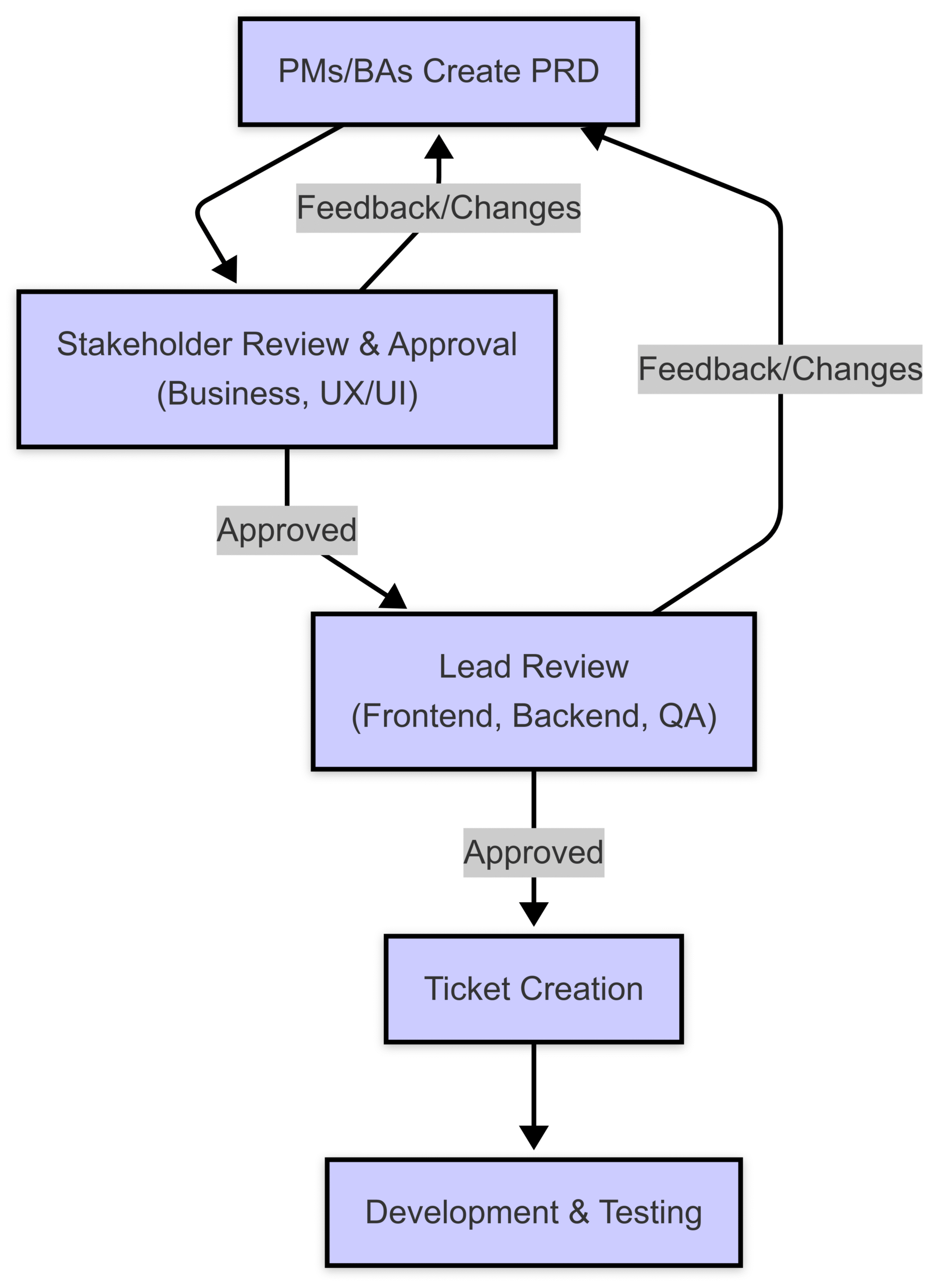Introduction
In software development, clarity in requirements is crucial. When requirements are unclear, testers struggle with ambiguities, leading to wasted effort in raising unnecessary defects and seeking clarifications. Our organization has adopted PRD-based ticketing, a process where Product Managers (PMs) or Business Analysts (BAs) create Product Requirement Documents (PRDs) using the BDD approach before development begins. This structured approach ensures that every stakeholder has a shared understanding, enabling a smoother workflow.
The Role of PRDs in Our Process
The PRD-based approach ensures that requirements are well-documented before any development begins. The process follows these steps:
- PRD Creation: PMs/BAs draft PRDs using the BDD (Behavior-Driven Development) approach.
- Stakeholder Review & Approval: PRDs are reviewed and approved by key stakeholders.
- Ticket Creation: Once approved, detailed tickets are created for frontend, backend, and QA teams.
- Review by Leads: Frontend, backend, and QA leads validate the tickets to ensure they align with requirements.
- Development & Testing: Development begins only after this structured review process.
This workflow ensures that testers work with precise, well-defined requirements, significantly reducing ambiguity and unnecessary defect logging.
Why This Process Matters for Testers
As testers, we often encounter situations where:
- Requirements are incomplete, leading to multiple rounds of clarification.
- Developers interpret requirements differently, causing inconsistencies.
- Testers raise defects that are later classified as “Not a Bug” due to unclear requirements.
By having well-defined PRDs reviewed before ticket creation, we mitigate these issues.
Example: Gherkin Scenario
Consider a PRD defining a login functionality using the BDD approach:
- Feature: Login functionality
– Scenario: Successful login
– Given the user is on the login page.
– When they enter valid credentials.
– Then they should be redirected to the dashboard.
With such structured PRDs, testers can design precise test cases early, reducing last-minute requirement changes.
The Impact of PRD-Based Ticketing on Testing
This structured approach has led to:
- Fewer requirement ambiguities: Testers no longer have to frequently clarify requirements.
- More effective test case design: Clear requirements allow testers to create comprehensive test cases upfront.
- Reduced unnecessary defects: Testers can focus on actual defects rather than issues caused by vague requirements.
- Better collaboration: All stakeholders, including testers, have a clear understanding of requirements before development begins.
Visualizing the Process
The following flowchart illustrates our PRD-based ticketing approach:

Conclusion
Shifting to a PRD-based ticketing system has streamlined our testing workflow by ensuring that all requirements are defined, reviewed, and validated before development starts. This approach has minimized unnecessary defect logging, improved collaboration, and enabled testers to focus on meaningful test scenarios. By adopting this strategy, teams can significantly enhance the efficiency of their software development lifecycle.
FAQs
1. What is a PRD-based ticketing system?
A PRD-based ticketing system uses detailed Product Requirement Documents (PRDs) as the foundation for creating development and testing tickets. It ensures requirements are defined and approved before work begins, reducing ambiguity.
2. How does PRD-based ticketing improve testing workflows?
By providing clear, reviewed requirements up-front, it minimizes guesswork, reduces unnecessary defect reports, and allows testers to design precise test cases early, improving overall testing efficiency.
3. What role does BDD play in PRD-based ticketing?
Behavior-Driven Development (BDD) formats PRDs in executable scenarios (e.g., Gherkin) that clearly define expected system behavior, making it easier for testers to align test cases to requirements.
4. How does this approach help reduce “Not a Bug” defect classifications?
Clear, comprehensive PRDs reduce misunderstandings that often cause testers to log defects for features behaving as intended, thus lowering false positives.
5. Who is involved in the PRD-based ticketing process?
Product Managers or Business Analysts draft PRDs, stakeholders review/approve them, then development and QA leads validate the derived tickets before implementation starts.
6. Can PRD-based ticketing improve team collaboration?
Yes. Because all stakeholders agree on the documented requirements early, communication barriers reduce, fostering smoother cooperation between PMs, developers, and testers.
QABash Nexus—Subscribe before It’s too late!
Monthly Drop- Unreleased resources, pro career moves, and community exclusives.
